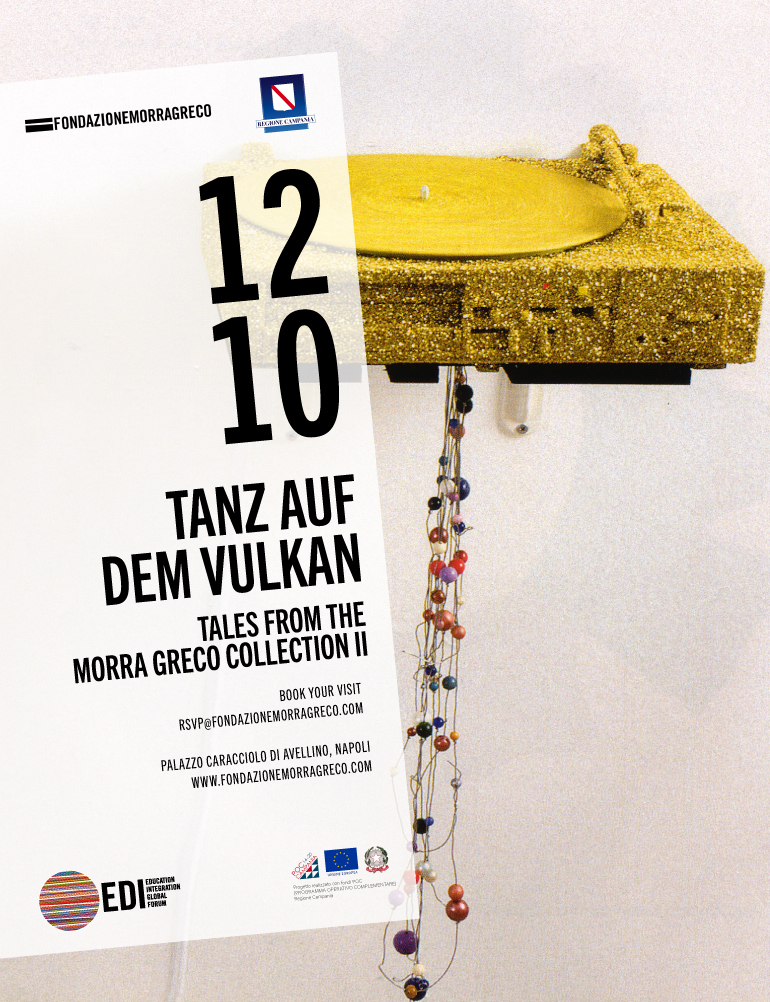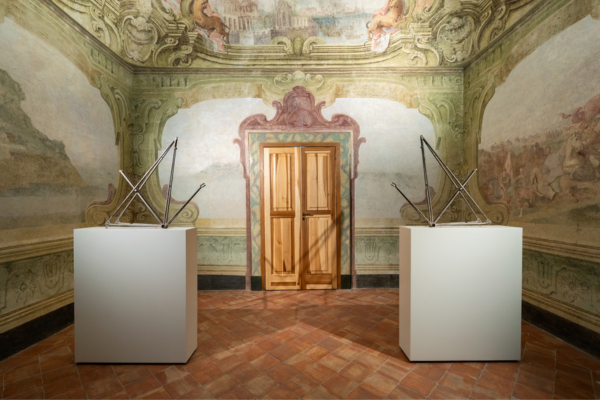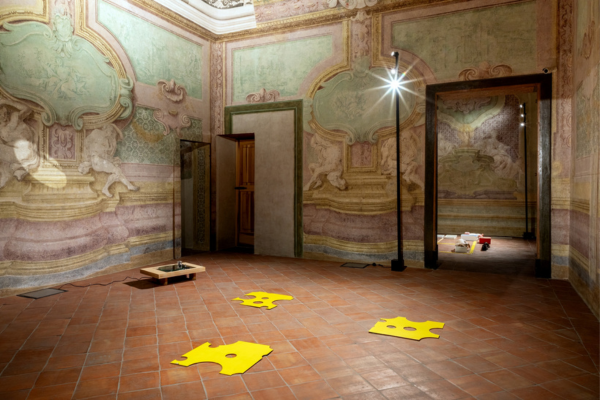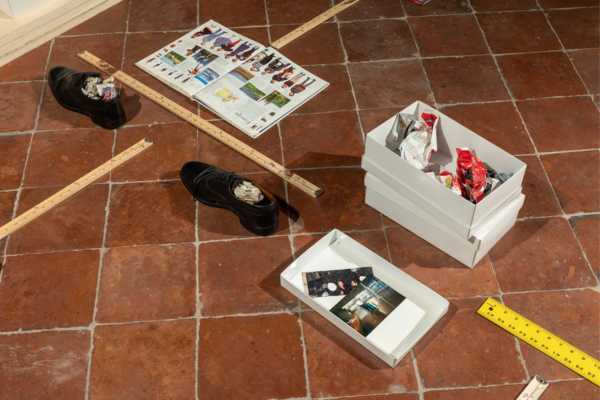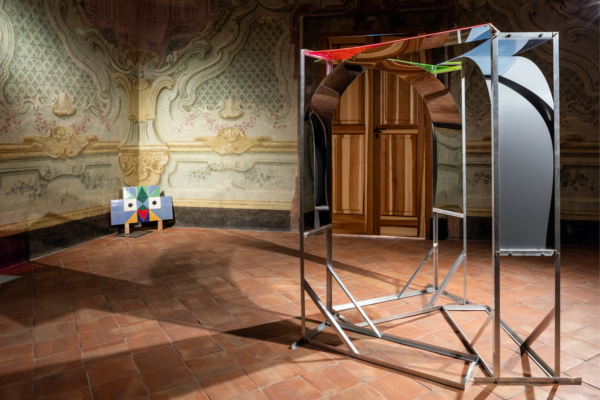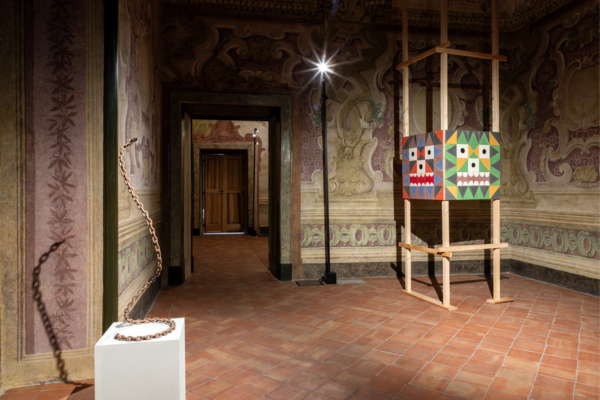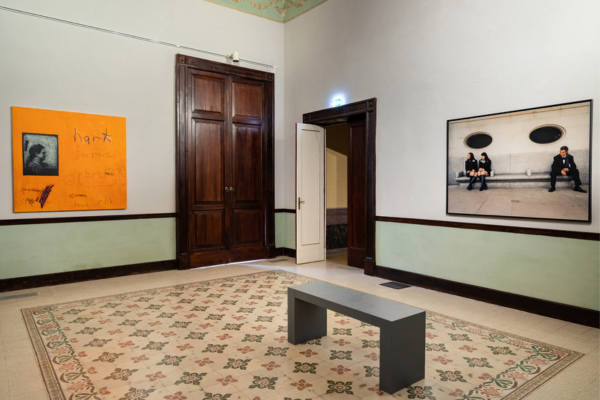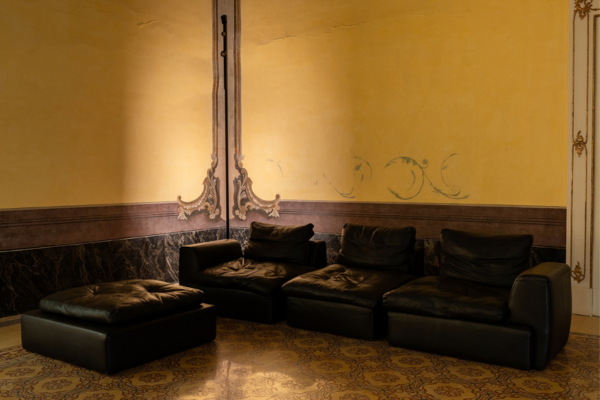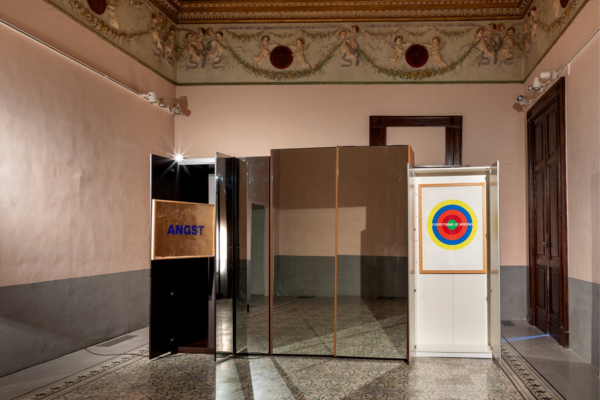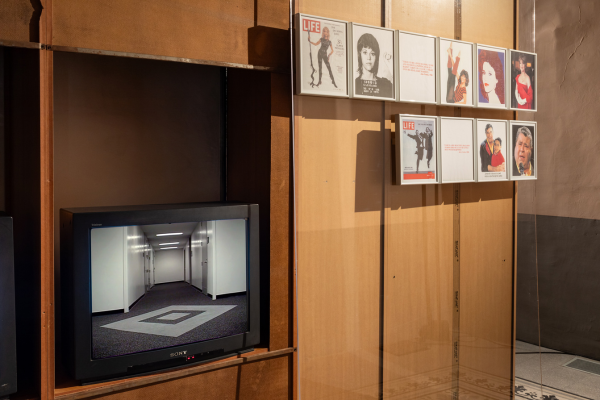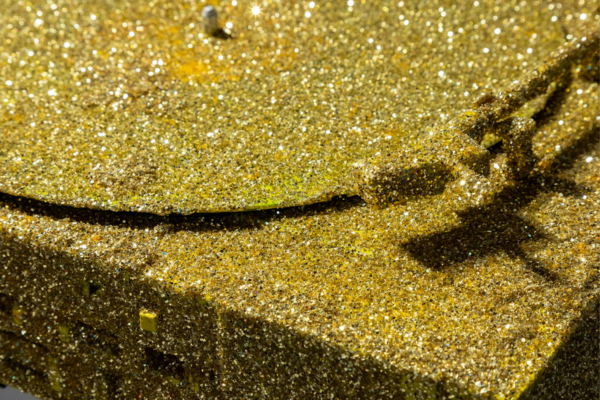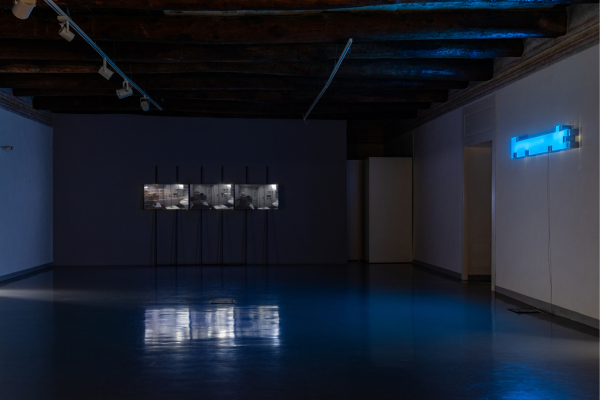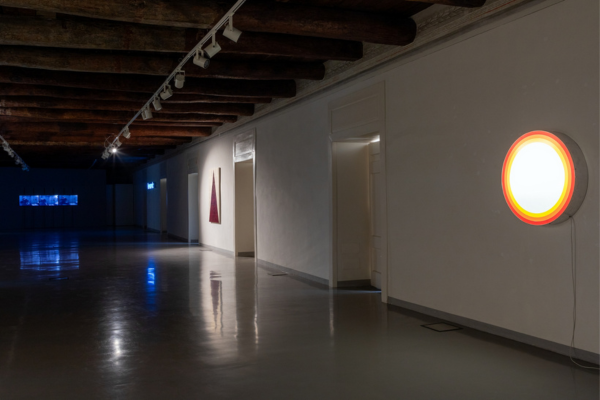12.10.2023 \\ 27.01.2024
CANDICE BREITZ | ADRIANO COSTA | LOTHAR HEMPEL |EVAN HOLLOWAY |JUDITH HOPF | JONATHAN HOROWITZ | JIM LAMBIE | MILTOS MANETAS | WIN MCCARTHY | RYAN MENDOZA | HELEN MIRRA | HENRIK PLENGE JAKOBSEN | DANIEL PFLUMM | HANNAH STARKEY | SIMON STARLING | JOHN PILSON | TIM ROLLINS & K.O.S. | HIROSHI SUGITO
The exhibition TANZ AUF DEM VULKAN presents a selection of paintings, sculptures, installations, photographs and videos from the Morra Greco Collection. The works in the exhibition interrogate the legacy of modernism through a critical reading of art, society and individual life in late capitalism.
The title TANZ AUF DEM VULKAN refers to a 1938 German musical. Its title was inspired by a speech made in 1929 by German foreign minister, Gustav Stresemann, who used the expression “dancing on a volcano” to describe German society, in the midst of turbulent change at the time. The title was then used for a 1998 documentary film, Berlin Techno Sex: Tanz auf dem Vulkan capturing Berlin’s techno gay scene, set within the musical subculture community, the world of clubbing, transgression and escape which characterised – more generally – the spirit of the early 2000s and the period after the fall of the Berlin Wall.
It was the time of a world nurtured by mass production, the first cell phones, wide-spread internet-use and post-human fantasies, all within the framework of a large, nascent, hyper-connected global village. It was the era of raves and techno music, synthetic drugs and acetate tracksuits, threatened by the looming global AIDS crisis. It was also a time characterised by the climate of growing political activism, protests and uprisings that contradicted the wide, new, interconnected consumer society. Ultimately, it was the consolidating era of post-industrial capitalism where – in the aftermath of the great non-end of the world and the new millennium – it seemed as if time was folding in on itself, repeating again and again only slightly deviating from its trajectory.
TANZ AUF DEM VULKAN, therefore presents a look at international art in the early 2000s, particularly emphasising the Morra Greco Collection’s bound to Central European and German art, as the exhibition’s title suggests. Part of the show also displays the projects carried out at Fondazione Morra Greco throughout its twenty year long activity, where several site-specific works were conceived specially for Palazzo Caracciolo di Avellino before its restoration in 2015.
These include Judith Hopf’s ceramics, realised in 2012, where the artist played with hallways’ scaffolding and support structures presenting them as fictitious characters. The temporary reinforcements were originally erected to secure the structurally unstable rooms, echoing the precariousness of Naples, which was struck by a violent earthquake in the 1980s. “Dancing on a volcano”, thus, symbolising the city of Naples and the tumultuous transition that defined the passing from one millennium to the next, embodying the precarious instability and perpetual work-in-progress that forever characterises the landscape of the city.
All the works on display somehow use symbols and icons that resonate with the spirit of modernity. It is through this postmodern language that this generation of artists came to problematize certain issues and concerns: from those related to form and artistic composition, such as Evan Holloway’s sculptural works or Ryan Mendoza’s painting; to others concerning the interstice between reality and fiction in consumer culture, as in Jonathan Horowitz’s collages; or the statute of the pictorial image in the digital world, as in the 1999 POWERBOOK series by Miltos Manetas, who is at once painter, pioneer of Post-Internet art and founder of the cryptic movement “Neen”.
Some of the works on show thus represent the new universe of digital signs and codes that arose from the virtual realm, defining a distance of the online from the offline world. A tendency that finds a direct counterpart in Helen Mirra’s meticulously crafted work in wool and wood, Railroad Ties (Sleeper) IV (2000), a photograph of a railroad before the rails are laid and the constructed road travelled. Something similar to the ironic, anti-modern reaction in the “poor” materials works of British artist Simon Starling.
Amidst the ruins of this self-confessed modernity are the pits left in the collective memory by pop culture, transfigured in the intimate one-take hummed by Candice Breitz, who films herself reflected in the windows of a train compartment on a journey in Me Myself I, 2001, from the title of a song by Joan Armatrading, or the installation Garden Path Sentence, 2021, by Win McCarthy, expressly adapted by the artist in occasion of the exhibition; a sort of portrait through personal objects, material culture, and the urban landscape elements that measure the perimeter of individual life.
A more intimate and hidden dimension of an isolated individual in a global village, separated from a tumultuous world through the membrane of a personal sphere, one identity among many who is rendered anonymous behind a computer screen, connected, but isolated, as in a gigantic Matrix. Likewise, installed inside a display designed by architects Las Ricas, Jonathan Horowitz’s collages parade like a slideshow of images from the pages of lifestyle magazines like LIFE or appear like posters attached to the wardrobe doors of a small bedroom.
The separation between private and public, personal and collective blurs and fades; the symmetry of the grid that separates them is annihilated, as in the video Above the Grid (2000) by John Pilson that loops simultaneously on the two televisions in the centre of the great hall on the second floor. Pilson’s art evokes the idea of the office, the myth of the city and the “wolves of Wall Street” in their suits and ties. Yet, his practice still speaks to us today about a less quantifiable form of cognitive capitalism: an enormous machine of alienation that feeds our never-off-always-connected culture of estrangement.
It is this same sense of estrangement that is portrayed in the feminine universe of fashion magazines – such as in Hannah Starkey’s glossy, stiffened poses – and which is part of another strand of the stereotyped image’s reflection and use; this time however, within the female sphere, a contamination between the languages of art, fashion and mainstream communication. A different discourse unites and differentiates – in certain respects – the work of artists such as Jim Lambie, Henrik Plenge Jakobsen, Daniel Pflumm, Tim Rollins & K.O.S. (Kids of Survival).
Both Henrik Plenge Jakobsen and Tim Rollins outline art within a relational and collaborative context, although in different ways. Plenge Jakobsen is historically embedded in Nicolas Bourriaud’s “Relational aesthetics” theory. In 1996, Plenge Jakobsen participated in the exhibition Traffic at CAPC in Bordeaux, which set forth the momentum for relational art, from which he immediately distanced himself. While, Tim Rollins & K.O.S. is a collective that mainly operated in New York, formed from a collaboration between Rollins and a group of youths from the South Bronx, where they explored art as a form of collaboration and creativity as an agent of social change.
Jim Lambie and Daniel Pflumm reflect on art that starts from a premise of “community”. However, the “community” from which their work takes its cue is more of an “escapist” and alternative community, that of subculture and music. The no-logo aesthetics and assumptions that dominate clubs and discos are integrated into Pflumm’s works, such as those on show at the third floor of Fondazione Morra Greco, which consist of advertising light-boxes from major brands, void of their titles and inscriptions. For example, on the Panasonic or MasterCard signs only the empty, luminous silhouette remains in Pflumm’s work. Somewhat similarly, the idea of music and celebration, community, intoxication and the psychedelic are recurring atmospheres in the work of Scottish artist Jim Lambie, which conceal an underground emptiness beneath the glittering façade.
The symbolic role of music and subcultures thus takes over to create transformative experiences that can give rise to narratives of mass community identity and social alternatives. Artists such as Adriano Costa, Lothar Hempel and – from another point of view – Hiroshi Sugito all do something similar. By subtracting the grandeur and other elements from everyday life, they redevelop modest objects or elements to reveal unexpected scenarios that magnify and make us reflect on the symbolic value attributed to art. Just like Hiroshi Sugito’s series of paintings, which are created in a semi-abstract language and nourished by light and small gestural details that echo the elegance of traditional Nihonga painting. This series marks one of the most recent acquisitions by the Morra Greco Collection in a sign of continued growth towards a “contemporary” direction: capable of capturing the historic moment, but focused on directions and trajectories that remain partially overlooked.
Concept and text by Giulia Pollicita
The exhibition project is financed from the POC Campania FESR 2014/2020 resources, Strategic Plan Culture and Cultural Heritage Programming 2021 Global Forum – Mostre d’arte contemporanea EDI 2021.
Browse the Gallery
Photo by Danilo Donzelli, Courtesy Collezione Morra Greco

